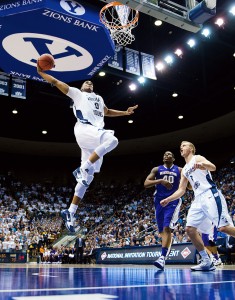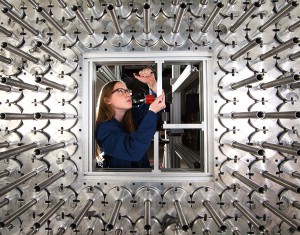The pictures gracing sports posters and the BYU website are familiar to students, but few know the people behind the camera.

Mark Philbrick and Jaren Wilkey, BYU’s primary photographers, were recently recognized for their outstanding work in the visual arts at a symposium for the University Photographers’ Association of America.
The annual, week-long symposium includes lectures, a location shoot and a photography competition. The 85 photographers who attended this year’s symposium in Chicago could submit a total of six prints per university and one multimedia presentation. The awards are decided by the members themselves.
“It makes it unique because we have peers judging peers,” Philbrick said. “Outside judges don’t understand.”
BYU’s winning multimedia submission was a behind-the-scenes mockumentary promo video for the university’s mathlete team. The photographers created the video to try and show that BYU is capable of creating art pieces that are both technically excellent and humorous.
“BYU is not known for being funny,” Wilkey said. “We’re trying to change that.”
The photography department has been recognized multiple times by the UPAA. Philbrick has been named Photographer of the Year seven times, and Wilkey received his first Photographer of the Year award in 2011. The multimedia presentations of the past two years placed third and second, respectively. Prints submitted into the sports action, people and portraits and photo essay categories received awards, and Wilkey won first place for his science and research submission.
Being recognized for their work is not the only reason the BYU photographers enjoy attending the symposium. According to Philbrick and Wilkey, the most exciting part of the week is learning from other photographers. Photography is an evolving field, with experts developing new techniques that offer a new perspective on their subjects.
Because photography is always changing and progressing as technology improves, the BYU photography department chooses to hire students who are willing to work with the department for several years and build a career. Much of the success of photographers comes through collaboration and experimentation.

(Photo by Jared Wilkey)
As the world changes, university photographers have to adapt to ensure that their work is still relevant. Wilkey said one of the biggest threats to professional photography is smartphones users’ ability to take pictures and upload them to social media sites almost instantaneously. Although his cameras can capture images of highly superior quality, the pictures that are getting attention are the first ones released from a smartphone. It is no longer enough to take pictures of a basketball game on Saturday and have the slides ready by Wednesday.
“Our goal is to have both quality and immediacy,” Philbrick said.
To combat the smartphone frenzy, Wilkey developed a system to allow him to deliver pictures straight from his camera to the Internet. He attached a file transfer device and connected it to a wireless network, allowing him to release high quality pictures immediately.
“We had pictures of Ziggy Ansah holding up his new jersey in 28 seconds,” he said of the NFL draft of the BYU defensive end.
According to Wilkey and Philbrick, photography is now a trade that anyone can access by learning the necessary skills on the Internet. The artistic aspect comes from learning new techniques that allow a photographer to create something that hasn’t been seen before. Events like the symposium allow professionals to see the perspectives of other artists from places as far away as Israel and Australia.
The ability to adapt to new styles and new technologies while maintaining aesthetic excellence is the mark of an award-winning university photographer, as Philbrick and Wilkey are well aware. Their role as “visual historians” of the school means that their work will stand as a representation of this era of the university, and their work reflects this high responsibility.




